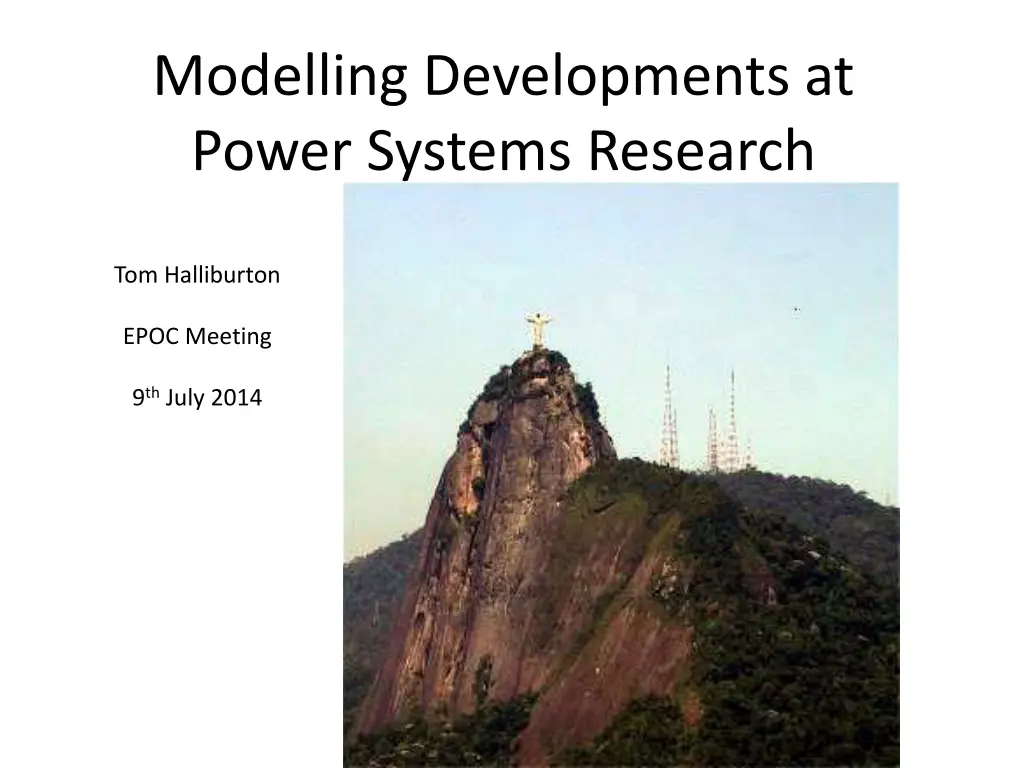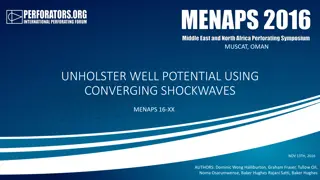
Developments in Power Systems Research: Modelling and Challenges
Explore the latest developments in power systems research, including modelling advancements, at PSR Power Systems Research. Discover insights on software tools like SDDP for planning and optimization, as well as current issues in risk management for hydro reservoirs. Gain valuable knowledge on parallel processing, fuel supplies, and more in the power industry.
Download Presentation

Please find below an Image/Link to download the presentation.
The content on the website is provided AS IS for your information and personal use only. It may not be sold, licensed, or shared on other websites without obtaining consent from the author. If you encounter any issues during the download, it is possible that the publisher has removed the file from their server.
You are allowed to download the files provided on this website for personal or commercial use, subject to the condition that they are used lawfully. All files are the property of their respective owners.
The content on the website is provided AS IS for your information and personal use only. It may not be sold, licensed, or shared on other websites without obtaining consent from the author.
E N D
Presentation Transcript
Modelling Developments at Power Systems Research Tom Halliburton EPOC Meeting 9th July 2014
PSR Power Systems Research Inc Offices in Rio de Janeiro Founded in late 1980s by Mario Pereira Now has 47 staff Work split equally between consulting and software sales And equally between local and overseas customers Customers world wide most countries with significant hydro generation
SDDP mid term planning OptGen Investment planning NCP short term scheduling
SDDP faster solves Parallel processing Base SDDP licencing allows parallel processing on one PC Base Xpress solver allows two simultaneous processes on each licence Enhanced version of SDDP for parallel processing across multiple networked PCs Two parallel processes reduces CPU by approx 60% Faster solves with Cut Relaxation Each iteration, size of LP problem increases, e.g. 18% from 1st to 2nd iteration. Eliminate redundant future cost function cuts from the one stage LP problems automatically, rather than allowing user to select based on a rule
Fuel Supplies Fuel supply contracts Take or pay contracts, General limits of rates and quantities of fuel supplies Fuel storage Coal stockpiling, gas storage Multiple fuel contracts, supplying multiple stations Take or pay, fuel storage add dimensions to future cost function
SDDP chronological Chronological modelling within each week Hourly Trial version completed Flow delays down rivers Hydro plant head pond constraints Thermal plant ramp rates Random variations in wind generation Time of day effects for solar power Requires massive parallel computing Conceptually all the one stage optimisations can be carried out simultaneously (e.g. 50 per stage, 360 stages)
Current Issues Modelling of risk averse management of hydro reservoirs Apply a more risk averse approach based on a willingness to give up some expected returns to reduce probability of deficit Approximating head effects at hydro stations without creating non-convex future cost function Possibly take or pay contracts for hydros
Cloud Computing on Amazon Servers All three models available on Amazon PSR the first South American customer for Amazon, over 2 years ago Costs US$0.50 per processor, per hour Covers Amazon charges and Xpress LP solver licencing fees Processor cost has come down as most customers want storage, not CPU power Opens up new opportunities for parallel processing OptGen 20 year case, 80 iterations, 5.5 hours elapsed, using 16 processors SDDP Chronological
OptGen Optimal Generation System Expansion Planning Includes all the usual constraints for expansion planning Find the optimal expansion plan using a MIP solver, minimising investment + operational cost Investment costs known for each plant System operation costs must be calculated for each node in the MIP problem Repeated calculation of operational cost for different expansion plans result in an improving representation of the system operating cost function Cost function has a similar form to the future cost function calculated by SDDP.
OptGen Algorithm Objective: Minimise C(x) + W(x) where C(x) investment cost W(x) operating cost X(t,j) is a matrix representing new generation commissioning program
OptGen with SDDP Simple mode - OptGen calculates operational cost for a number of scenarios Alternatively, use SDDP: OptGen calculates an optimal expansion plan SDDP calculates the system operating costs OptGen re-calculates the expansion plan using this new information Allows plant operating capabilities and constraints to directly influence expansion planning. End result is a least cost expansion plan and an SDDP model setup for this plan.
OptGen + SDDP Distinguishes between run of river hydros and those with storage. Waitaki North Bank will benefit from storage management, Arnold scheme will not. Full effects of variability of hydro inflows reflected in planning Accounts for extra plant that might be needed to cover dry periods Thermal unit commitment options Base load or peaking capabilities Coal stockpiling, gas storage Take or pay fuel contracts associated with new plant Variability of wind, solar can be modelled in more detail
OptGen Trials Trial study of New Zealand system 20 year study 80 iterations, 5.5 hours elapsed with 16 processors Results look reasonable
NCP Detailed scheduling model hourly, hourly or 15 minute time steps Used for detailed day ahead planning etc. where ramp rates, start up costs, interaction of hydro plants in a river system need to be modelled Used in centrally planned and dispatched systems A model of this type is likely to be needed if the NZ Power single buyer scheme were to eventuate.
NCP Chronological Latest extension enables SDDP model results to be studied in more detail Solve a full year with NCP, working from an SDDP solution to give a detailed picture of one or more flow scenarios Options to enforce SDDP s mid-term strategies: Use water value for end of period storage End of period reservoir levels as a target Total generation each period for each hydro plant


